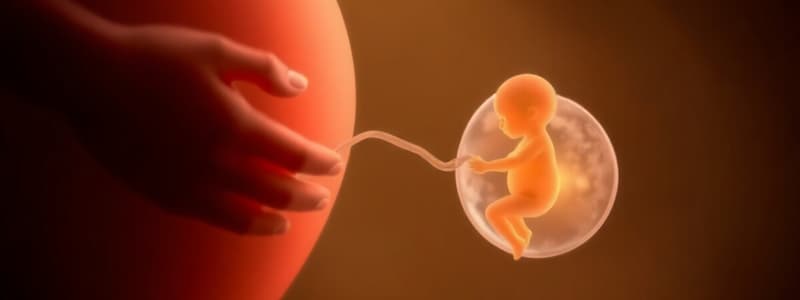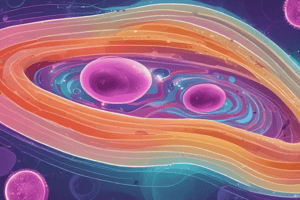Podcast
Questions and Answers
What is the term for the developing offspring?
What is the term for the developing offspring?
- Embryo
- Fetus
- Conceptus (correct)
- Zygote
What is the name for a new fertilized ovum?
What is the name for a new fertilized ovum?
- Fetus
- Zygote (correct)
- Embryo
- Conceptus
Until which week of development is the term 'embryo' used?
Until which week of development is the term 'embryo' used?
- 8th (correct)
- 16th
- 9th
- 12th
After the 9th week until birth, what is the developing offspring called?
After the 9th week until birth, what is the developing offspring called?
What event occurs when a sperm's chromosomes combine with those of an egg?
What event occurs when a sperm's chromosomes combine with those of an egg?
Which of the following must occur before penetration during fertilization?
Which of the following must occur before penetration during fertilization?
When does the first cleavage division occur after fertilization?
When does the first cleavage division occur after fertilization?
What is the name for the solid ball of cells that forms around 72 hours after fertilization?
What is the name for the solid ball of cells that forms around 72 hours after fertilization?
Around which day does the blastocyst typically reach the uterus?
Around which day does the blastocyst typically reach the uterus?
A blastocyst is described as a fluid filled ball of cells, what cells are flattened?
A blastocyst is described as a fluid filled ball of cells, what cells are flattened?
Which cells of the blastocyst participate in placenta formation?
Which cells of the blastocyst participate in placenta formation?
What structure does the inner mass cells from the blastocyst eventually become?
What structure does the inner mass cells from the blastocyst eventually become?
Around how many days after ovulation does implantation begin?
Around how many days after ovulation does implantation begin?
Which of the following best describes how the trophoblast interacts with the endometrium?
Which of the following best describes how the trophoblast interacts with the endometrium?
What hormone is secreted by trophoblast cells, and later the chorion?
What hormone is secreted by trophoblast cells, and later the chorion?
What event is prevented by human chorionic gonadotropin (hCG)?
What event is prevented by human chorionic gonadotropin (hCG)?
What two tissue types contribute to placenta formation?
What two tissue types contribute to placenta formation?
By which month of pregnancy is the placenta fully formed?
By which month of pregnancy is the placenta fully formed?
Which extraembryonic membrane contributes to the formation of the placenta?
Which extraembryonic membrane contributes to the formation of the placenta?
During embryonic development up to week 8, what three germ layer form? Select one of the layers.
During embryonic development up to week 8, what three germ layer form? Select one of the layers.
Flashcards
Coitus
Coitus
Sexual union between a male and female.
Pregnancy
Pregnancy
Events that occur from fertilization until birth.
Conceptus
Conceptus
The developing offspring in the uterus.
Zygote
Zygote
Signup and view all the flashcards
Embryo
Embryo
Signup and view all the flashcards
Fetus
Fetus
Signup and view all the flashcards
Fertilization
Fertilization
Signup and view all the flashcards
Cleavage
Cleavage
Signup and view all the flashcards
Morula
Morula
Signup and view all the flashcards
Blastocyst
Blastocyst
Signup and view all the flashcards
Trophoblast Cells
Trophoblast Cells
Signup and view all the flashcards
Inner mass cells
Inner mass cells
Signup and view all the flashcards
Implantation
Implantation
Signup and view all the flashcards
Implantation Completion
Implantation Completion
Signup and view all the flashcards
Placenta Formation
Placenta Formation
Signup and view all the flashcards
Chorion
Chorion
Signup and view all the flashcards
Amnion
Amnion
Signup and view all the flashcards
What are germ layers
What are germ layers
Signup and view all the flashcards
Gastrulation
Gastrulation
Signup and view all the flashcards
Week 8
Week 8
Signup and view all the flashcards
Study Notes
Pregnancy
- Coitus refers to sexual union.
- Pregnancy encompasses the events from fertilization until birth.
- Conceptus refers to the developing offspring.
- The zygote is the newly fertilized ovum.
- The embryo develops from fertilization to the end of the 8th week.
- The fetus develops from the 9th week until birth.
Fertilization
- Fertilization occurs when a sperm's chromosomes combine with those of an egg to form a zygote.
- Sperm must navigate transport barriers and undergo capacitation to fertilize an egg.
- A sperm cell must breach the corona radiata and zona pellucida to fertilize an egg
- Sperm must bind to receptors on the zona pellucida before penetration
- Calcium channels open on the oocyte plasma membrane
- Entry of the sperm cell triggers the oocyte to complete meiosis II and shed other membrane receptors.
- Sperm binding to a membrane receptor triggers oocyte membrane block.
- There will be no place for other sperm to bind
- The oocyte completes meiosis II upon entry of sperm.
- An ovum pronucleus and a second polar body are formed.
- The male and female pronuclei subsequently fuse to produce a zygote.
Embryonic Development
- Cleavage is a period of fairly rapid cell division after fertilization.
- Mitotic divisions of a zygote result in daughter cells.
- At 36 hours the first cleavage occurs resulting in 2 daughter cells.
- At 72 hours the Morula stage is reached with 16+ cells.
- By day 3 or 4, the blastocyst, an embryo of about 100 cells, reaches the uterus.
- The blastocyst is a fluid-filled ball of cells with:
- Flattened trophoblast cells and
- A small cluster of rounded cells, known as inner mass cells.
- Trophoblast cells have immunosuppressive factors and participate in the placenta formation.
- The inner mass cells become the embryonic disc, which forms the embryo plus three of the embryonic membranes.
Implantation
- The blastocyst floats around the uterus for 2-3 days.
- Implantation begins 6-7 days after ovulation.
- The trophoblast adheres to a suitable site in the endometrium using proper receptors and chemical signals.
- An inflammatory-like response occurs in the endometrium during implantation.
- Trophoblasts consist of an inner cytotrophoblast and an outer synctiotrophoblast layer.
- Synctiotrophoblasts invade and digest the uterine wall (endometrium), ultimately contributing to placenta formation.
- Implantation is typically completed by the 12th day after ovulation.
- Menstruation must be prevented during pregnancy
- Human chorionic gonadotropin (hCG) is secreted by trophoblast cells, and later by the chorion. -hCG prompts the corpus luteum to continue secreting progesterone and estrogen.
- hCG prevents menstruation and promotes placental development.
Placentation
- Placentation involves both embryonic and maternal tissues which contribute to the placenta.
- The placenta is fully formed by the third month of pregnancy.
- Maternal and embryonic blood normally does not intermix.
- Embryonic placental barriers include membranes of chorionic villi and endothelium of embryonic capillaries.
- The placenta functions as a nutritive, respiratory, excretory, and endocrine organ.
- Sugars, fats, and oxygen diffuse from the mother to the fetus.
- Urea and carbon dioxide diffuse from the fetus to the mother.
- Syncytiotrophoblast cells in the placenta are responsible for hormone manufacture.
Embryonic Development
- Chorion = outermost; formation of placenta.
- Amnion = innermost; sac filled with amniotic fluid.
- Allantios = umbilical cord/bladder.
- Yolk Sac = part of gut/early circulatory development.
- Development spans from fertilization to week 8
- Three germ layers are responsible for tissue and organ development
- Ectoderm
- Mesoderm
- Endoderm
- Gastrulation sets the stage for organogenesis, which is the formation of body organs and systems.
- By 8 weeks organs have typically been formed
- The embryonic period comes to an end.
Studying That Suits You
Use AI to generate personalized quizzes and flashcards to suit your learning preferences.



